Sarah Legge, Australian National University; Georgia Garrard, The University of Melbourne; Jaana Dielenberg, Charles Darwin University; John Woinarski, Charles Darwin University, and Tida Nou, The University of Queensland
How we manage pet cats in our suburbs is in the spotlight. As the estimated number of pet cats in Australia passes five million, people are increasingly aware of the damage cats do to wildlife.
One-third of owners already keep their cats securely contained 24 hours a day. This has major benefits for cat welfare and prevents cats killing and disturbing wildlife. But that leaves the other 3.5 million or so pet cats free to roam for at least part of the day or night.
In Australia, local government is responsible for regulating our feline pets, but little is known about how this works in practice. We sent a survey to every local council in Australia to understand their approaches to managing pet cats and how these could be improved. We received responses from 240 councils (45 per cent).
Councils across Australia reported that managing pet cats is a challenge. But many are adopting regulations that help to protect local wildlife and improve the wellbeing of pet cats. However, state laws, especially in Western Australia and New South Wales, are making it difficult for local councils to manage pet cats well.
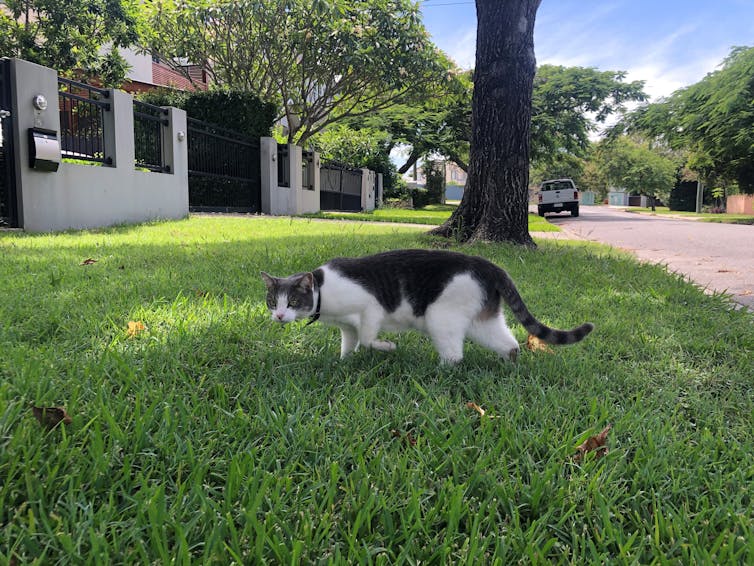
Cats kill more than their owners realise
Why the big deal? Many cat owners think their moggy is blameless. “I don’t think my cat goes out that much and I never see any dead animals,” they often say. This is largely untrue.
Research shows the impact of pet cats is much bigger than people realise. Many cats don’t bring home what they kill, or bring back only a very small proportion (15 per cent on average), so their owners aren’t aware of the majority of the wildlife toll. Radio-tracking studies have shown a large proportion of cats are out on adventures when their owners thought they were inside.
On average, each roaming, hunting pet cat in Australia kills 40 native reptiles, 38 native birds and 32 native mammals per year.
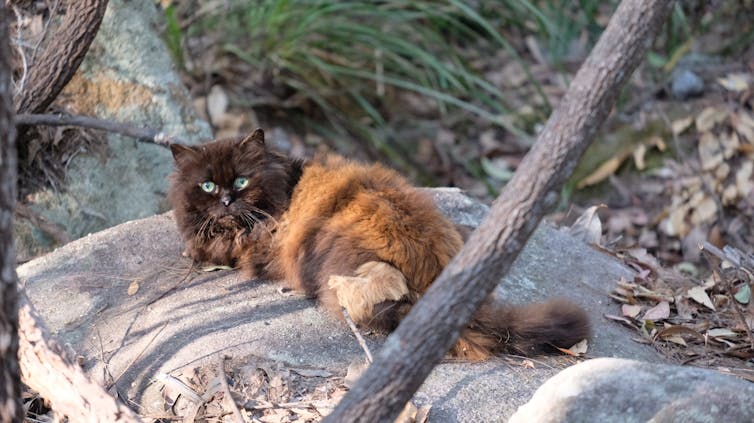
Our suburbs are now home to around 55 cats per square kilometre. That adds up to about 6000 native animals killed per square kilometre per year in our suburbs alone. The national wildlife death toll from pet cats is well over 300 million native animals per year.
Even when roaming cats don’t kill animals, they have negative impacts on wildlife by spreading diseases and because wildlife must spend more time hiding or escaping instead of feeding and caring for young.
As well as hunting wildlife, roaming pet cats can increase feral cat populations if unwanted litters are abandoned.
Seeing wildlife, like blue-tongued lizards and fairywrens, in our gardens and local parks is something we all cherish. How we manage pet cats can either jeopardise our co-existing wildlife or help to safeguard it. So we set out to examine how pet cats are being managed across the country.
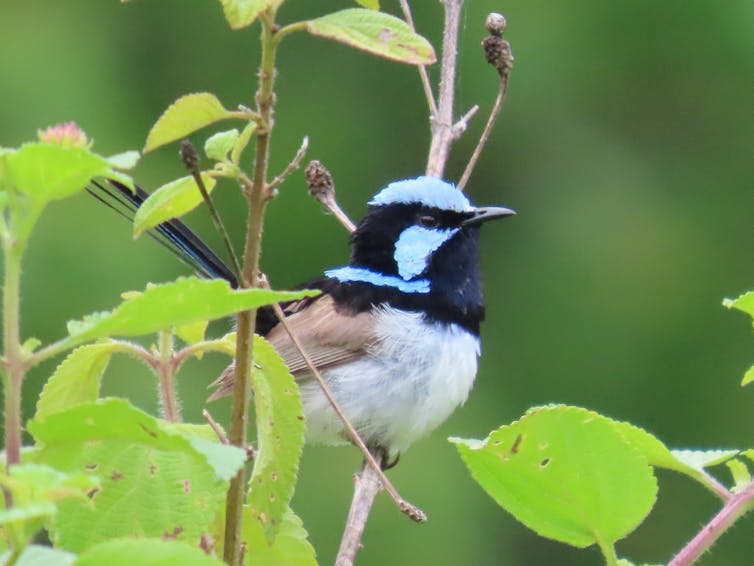
What are councils doing about it?
Our survey found almost all local councils require pet cats to be microchipped. Three-quarters require them to be registered. Just over half require desexing and limit the number of cats that can be kept per household.
These approaches are very important to manage pet cats and constrain their numbers and should be extended to all local government areas. However, these measures do not prevent pet cats roaming.
Concern about the impact of roaming cats has led almost one-third of councils to introduce cat-free areas, cat curfews and containment requirements at all or some places in their local government area. Where adequately policed, these measures appear to be working.
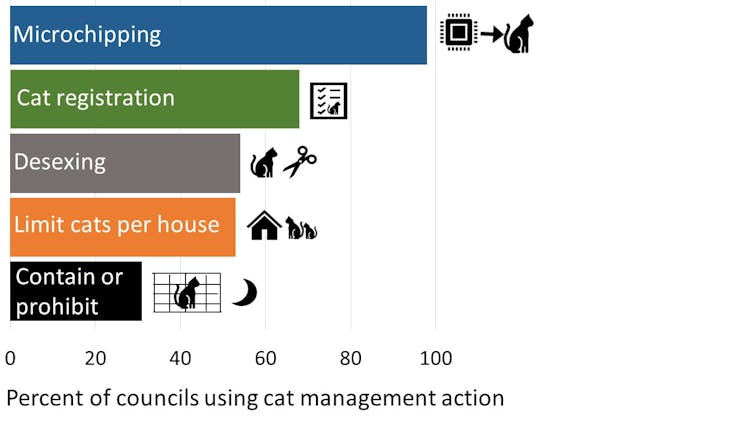
These approaches are most common in city areas of the ACT, Victoria and South Australia, and on some islands. The number of local government areas using this approach has grown markedly over the past five years, partly in response to growing awareness of the impacts of pet cats on wildlife.
For example, Adelaide Hills Council (SA) and Victoria’s Knox City Council brought in 24-hour containment last year. There are plans to do the same on Phillip Island (Victoria) later this year. Bruny Island (Tasmania) and Kangaroo Island (SA) both require cats to be contained. In NSW, Tweed Shire has designated some recently built and future suburbs, which are next to bushland with high conservation value, as cat free.
Christmas Island has gone further. All pet cats are desexed and the community has agreed not to bring in any more, so their numbers on the island are gradually dwindling.
Some state laws stand in the way of better protection
Many local councils would also like to adopt containment regulations and no-cat areas as part of strategies to protect local wildlife. However, the overarching laws on domestic animal management are set at the state level. If these laws don’t allow local government to set and then police cat containment bylaws, then the local councils can be hamstrung.
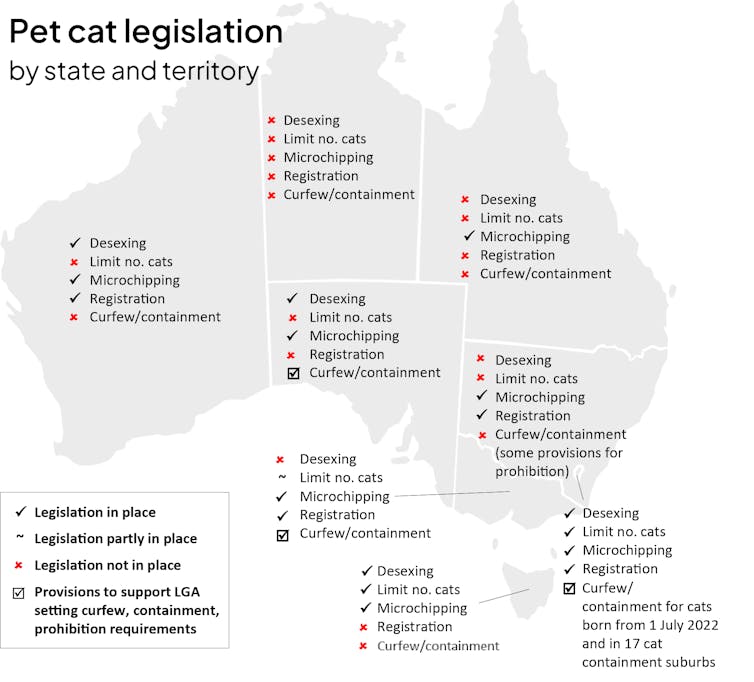
Local councils in WA and NSW complained most often about this situation. They want changes to state laws to make it easier for them to set and police local rules about cat containment or cat prohibition.
In SA, local governments noted inconsistencies in cat containment provisions between councils make implementation and enforcement challenging. A statewide approach using the SA Dog and Cat Management Act would be more effective.
To support fair and effective management of pet cats we recommend all states and territories adopt strong and nationally consistent legislation to enable responsible pet cat management.
This should be supported by enhanced community awareness programs and support for owners and their pets to make the transition to a new, contained lifestyle. Outcomes for local wildlife and for cat welfare and health should also be monitored.
Protecting wildlife and caring for our delightful pets can both be achieved if we rethink what it is to be a cat owner and support local government to manage these issues for the whole community.
Sarah Legge, Professor of Wildlife Ecology, Australian National University; Georgia Garrard, Senior Lecturer, School of Ecosystem and Forest Sciences, The University of Melbourne; Jaana Dielenberg, University Fellow, Charles Darwin University; John Woinarski, Professor of Conservation Biology, Charles Darwin University, and Tida Nou, Project Officer, School of Earth and Environmental Science, The University of Queensland
This article is republished from The Conversation under a Creative Commons licence. Read the original article.
Would you support more controls for cats? What would be your recommendations? Why not share your suggestions in the comment section below?

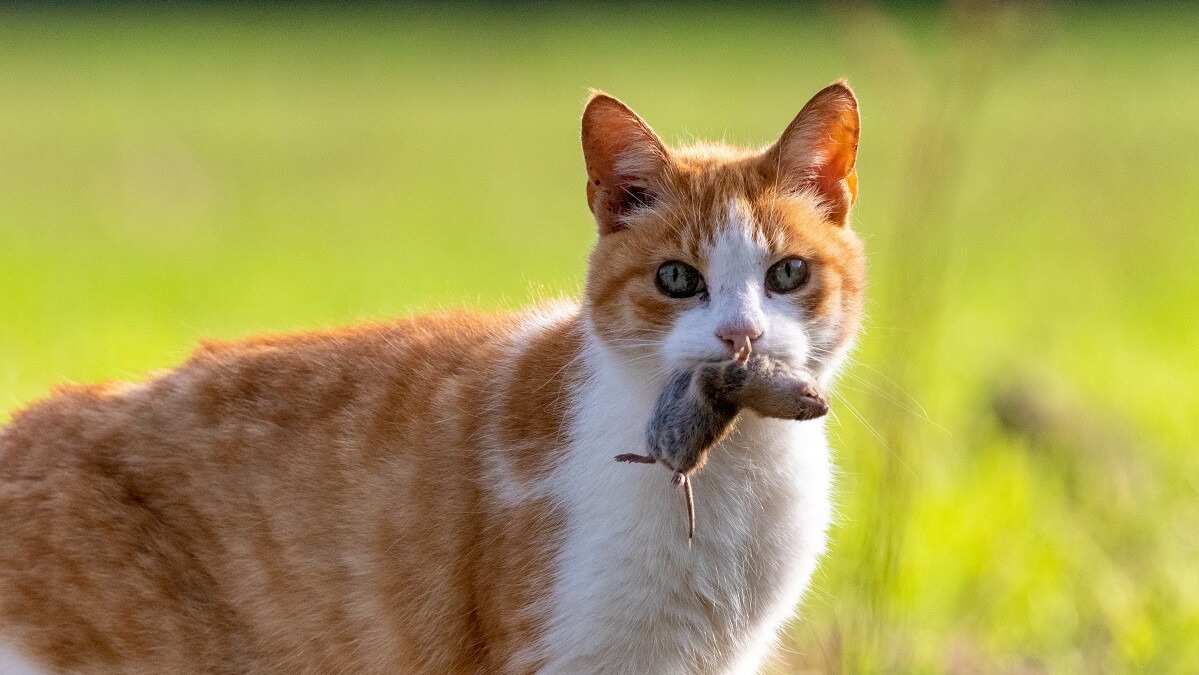
I found those statistics very surprising, the fact that (if I read the article correctly), that
Four states do not insist on desexing pet cats & why shouldn’t pet cats be registered like dogs have to be??
Unfortunately many cats belonging to some owners living near the bush or national parks are not constrained by their owners. I do not think councils have the power to deny cat registration to properties bordering parks. Even de-sexed cats can still cause damage as detailed in the above article. I have personally viewed and experienced the frenzied attack by cat resulting in the decapitation (head chewed up and body left in the garden) of two adult and one baby possum, one blue tongue lizard and one water dragon. Cats are predators and left to roam at night or during the day with their owners believing their tabby is a nice pet that would cause no harm.
Not a single sentance in this article about the benifits of cat ownership . All about more government control . Probably written by a non-cat owner.
I would like to see some recognition of the positive effects of cat ownership and balanced proposals to address the negative impact by cats on wildlife.
I live in a rural area and the councel bought in rules about microchipping ect and desexing and not allowed to breed cats unless a breeder, Hah they bought in these rules but dont follow up on them, They rely on neighbours dobbing in neighbours, People openly advertise on local groups they have kittens, and the councels take no notice nor do they follow up . Its usless rules because of that. Alot of rural people dont care about keeping their cats in at night evan,I have 3 and they are confined 24.7 with a run outside, I can relax knowing they are safe/ not annoying neighbours and not catching wildlife. Other people dont care about all that